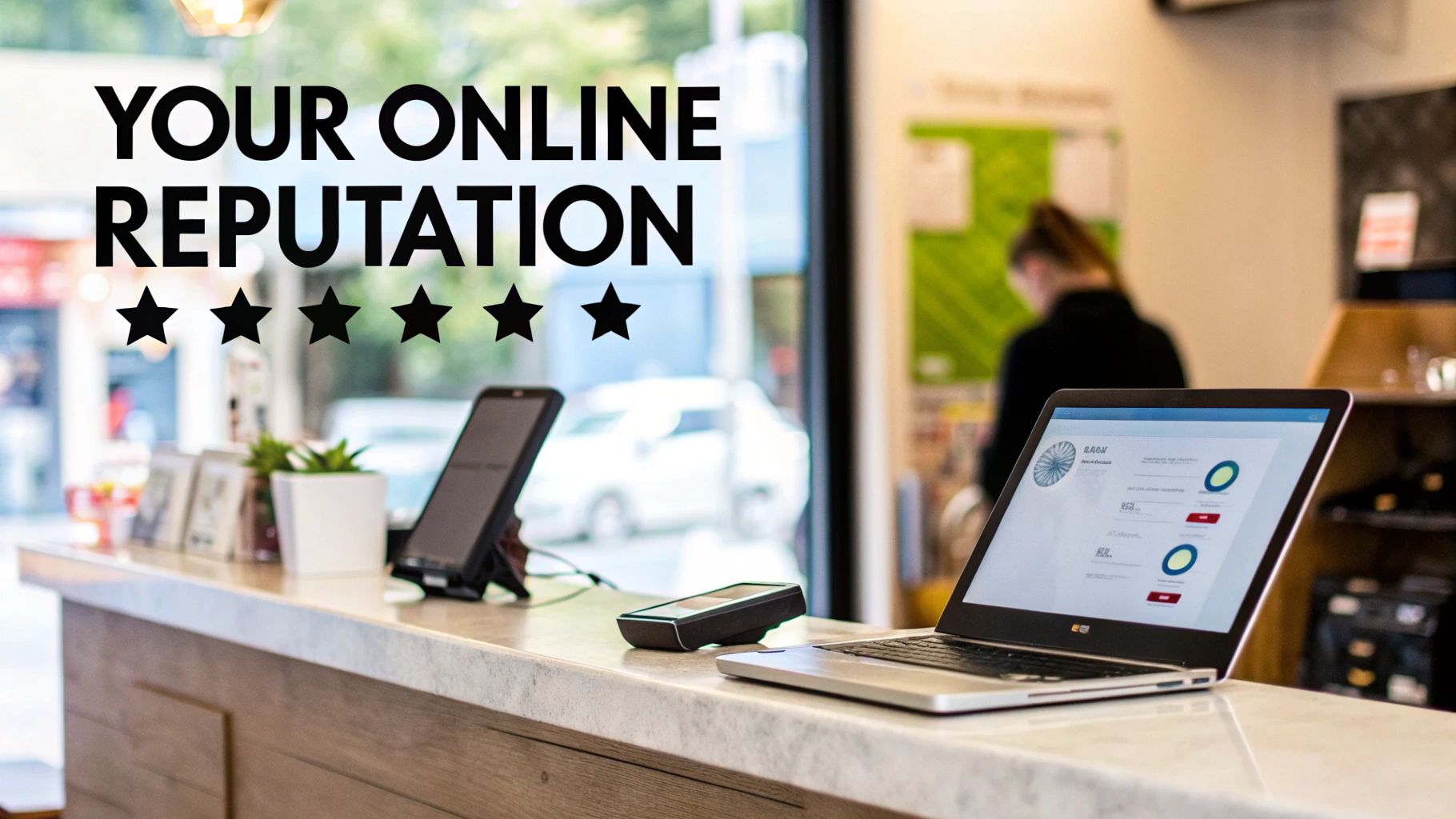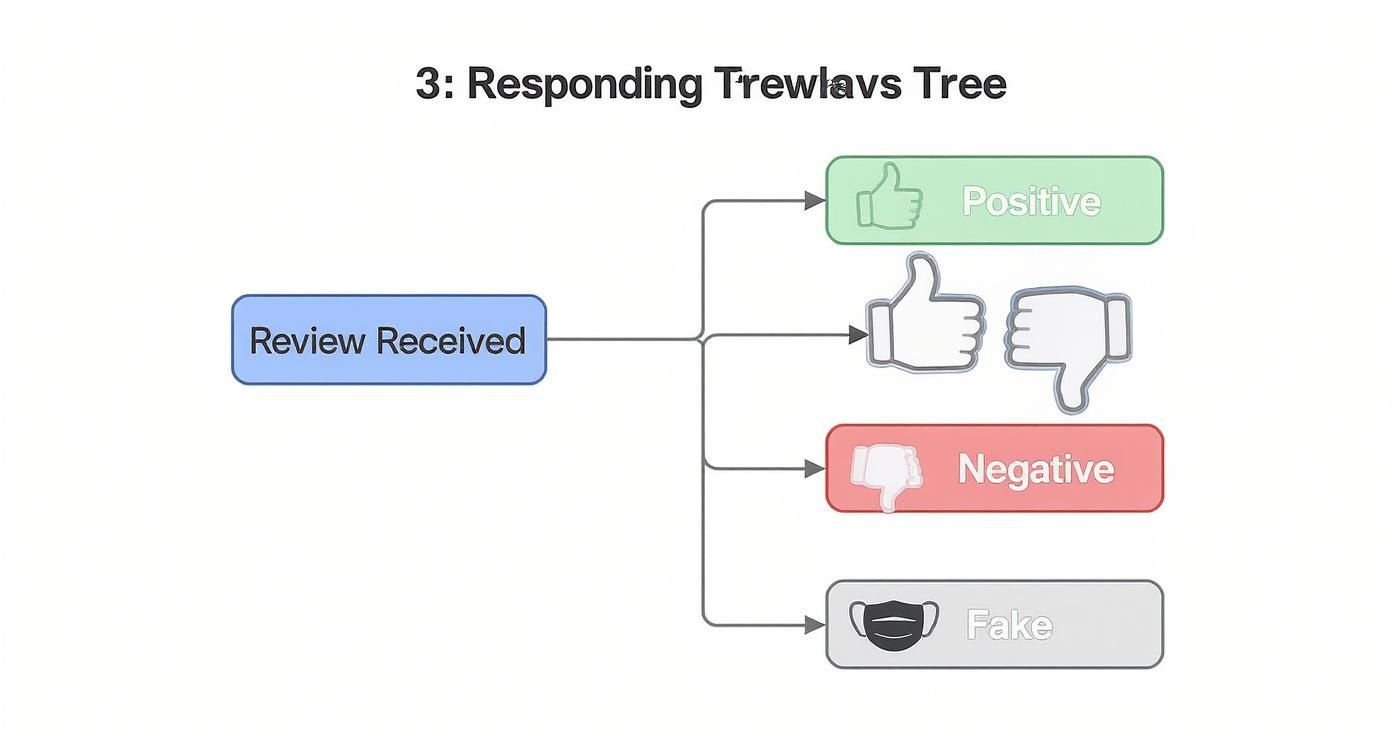
Online reputation management isn't just a buzzword; for a small business, it's the active work of listening to, engaging with, and shaping the conversation about your brand online. It’s about keeping an eye on brand mentions, thoughtfully responding to customer reviews, and intentionally building a digital presence that brings people through your door.
Why Your Online Reputation Is Everything

Think of your online reputation as your digital storefront. Every review, comment, and star rating is part of the display. It either entices potential customers to come inside or quietly convinces them to keep walking. It's the new word-of-mouth, but with a megaphone that can reach thousands of people in an instant.
This conversation about your business is happening whether you participate or not. A single negative review on Google, left unanswered, can turn away a customer who was just about to click "buy." On the flip side, a consistent flow of genuine, positive feedback can become your most powerful sales tool, working around the clock to build credibility.
The Foundation of Customer Trust
In a sea of competitors, trust is what makes you stand out. Before committing, people look for signals that your business is legitimate and that you deliver on your promises. Online reviews are that signal—they’re raw, unfiltered social proof from people just like them.
The numbers don't lie. Research consistently shows that online reviews are central to how people shop today. One recent study found that 93% of consumers read online reviews before buying something. Even more telling, a staggering 88% trust those reviews just as much as a recommendation from a friend. For a small business without a huge marketing budget, that kind of trust is priceless. You can dig deeper into how reputation drives growth and see the full study on HiFiveStar.
"Your brand isn’t what you say it is. It’s what Google says it is." - Chris Anderson
This quote nails it. Your polished website and clever marketing are only half the story. The other half is what people find when they search for your name—the star ratings, the gut-wrenching rants, the glowing praise. That's what truly shapes their perception and their decision to do business with you.
From Passive Worry to Proactive Strategy
It’s time to stop treating reputation management as a fire drill. Instead of waiting for a crisis to react, think of it as a core part of your daily operations. The goal is to build a resilient, positive presence from the very beginning. A proactive approach turns all feedback, good and bad, into fuel for growth.
To bring this to life, you need to understand the core activities that make up a strong reputation strategy. This table breaks down the essentials into manageable pillars.
Core Pillars of Small Business Reputation Management
| Pillar | Key Activities | Primary Goal |
|---|---|---|
| Monitoring | Setting up alerts for brand mentions, tracking review sites (Google, Yelp), and following social media conversations. | To know what's being said about you, where, and when, so you can respond quickly. |
| Responding | Replying to all reviews (positive and negative), engaging with social media comments, and addressing customer service issues publicly. | To show you're listening, build customer loyalty, and demonstrate excellent service to potential customers. |
| Building | Actively requesting reviews from happy customers, showcasing positive testimonials on your website, and sharing user-generated content. | To generate a steady stream of positive social proof that builds trust and outweighs any negative feedback. |
| Protecting | Flagging and reporting fake or malicious reviews, addressing misinformation, and having a plan for handling a PR crisis. | To defend your brand's integrity against unfair attacks and maintain a truthful online presence. |
By focusing on these four areas, any small business owner can create a system that not only protects their brand but also helps it thrive.
Building Your Reputation Monitoring System

You can't manage what you don't measure. Setting up a system to monitor your reputation is the first real step in taking control of your brand's story online. The good news? You don't need a huge budget to do this effectively. A smart, consistent process is worth far more than expensive software that sits unused.
Think of it as creating an early-warning system. It needs to catch conversations about your business—the good, the bad, and the ugly—so you can respond quickly and thoughtfully. This proactive approach stops you from being a bystander and makes you an active player in shaping your own narrative.
Start with Free and Simple Tools
From my experience, the best tools are the ones you actually use day-in and day-out. For most small businesses, a handful of free, accessible services provides all the coverage you need without adding another monthly bill to the pile.
- Google Alerts: This is your foundation. It's free, it's easy, and it emails you whenever a new article, blog, or web page mentions your chosen keywords.
- Social Media Notifications: This one’s a no-brainer. Go into your settings on Facebook, Instagram, LinkedIn, or wherever you have a presence, and turn on all notifications for mentions, tags, and comments. This is your front line.
- Review Platform Dashboards: Make it a weekly, if not daily, habit to log into your Google Business Profile, Yelp for Business, and any industry-specific sites like Tripadvisor. These are your most direct lines of customer feedback.
Getting these set up is simple. When you configure your Google Alerts, don't just stop at your business name. You need to cast a much wider net to catch everything.
The key to effective monitoring isn't just tracking your brand name. It's about listening to the entire ecosystem of conversations related to what you do, who you are, and the problems you solve for customers.
Think about all the different ways people might talk about you online. Building a solid list of keywords is crucial for a robust online reputation management for small business strategy.
What to Track Besides Your Business Name
A classic mistake is only setting up alerts for your official company name. People rarely talk that formally. You need to broaden your monitoring to include:
- Product and Service Names: Track your specific offerings, especially any signature products.
- Key People: Keep an eye on mentions of your CEO, founder, or other public-facing team members.
- Common Misspellings: You'd be surprised how often people get it wrong. Include frequent typos of your business name.
- Campaign Slogans or Hashtags: If you're running a marketing campaign, you absolutely need to monitor its unique tags.
- Competitor Names: See what people are saying about your direct competitors. Their weaknesses are often your opportunities.
This wider approach gives you a much clearer picture of where you stand. You won't just catch direct feedback; you'll uncover industry trends and competitive intel that can genuinely shape your business strategy. To really get a handle on the full feedback loop, check out this complete guide to collecting, analyzing, and acting on user feedback.
When to Consider Affordable Paid Tools
While free tools will get you surprisingly far, there comes a time when dedicated reputation management software makes sense. These platforms pull mentions from all over the web—social media, news sites, blogs, and review platforms—into one clean dashboard.
It might be time to look at a paid tool when:
- The volume gets overwhelming: You simply can't keep up with manually checking all the different platforms anymore.
- You need sentiment analysis: You want a quick, at-a-glance understanding of whether the buzz is positive, negative, or neutral.
- You want real analytics: You're ready to track trends over time, see who the key influencers are in your space, and measure your "share of voice" against competitors.
Many services offer affordable plans designed for small businesses. They save you an incredible amount of time, which is money you can put right back into running your company. A good system turns the random noise of the internet into a predictable source of business intelligence, helping you make smarter moves every single day.
How to Respond to Every Type of Customer Review
This is where the real work of reputation management happens. Every single time you reply to a review, you're having a public conversation. It’s your chance to show what your brand is all about and prove to potential customers that you’re actually listening. A smart response strategy can turn simple feedback into your most powerful tool for building trust.
A common mistake I see business owners make is thinking only negative reviews need a reply. That's a huge missed opportunity. When you engage with positive feedback, you're high-fiving your happy customers, making them feel great about choosing you, and encouraging them to come back. You're also showing everyone else what a great experience looks like.
The Anatomy of a Perfect Response
Before we get into the nitty-gritty of different review types, let's establish a solid foundation. Whether you're dealing with a one-star disaster or a five-star rave, a great response shares the same DNA. This isn't about having a canned template, but a consistent, authentic approach.
A really strong response almost always includes:
- A personal touch: Use their name. It’s simple but effective.
- Specific acknowledgment: Reference something they actually mentioned in their review.
- A dose of gratitude: Thank them for taking the time to leave feedback.
- An invitation or a solution: Offer to fix things or invite them to come back again soon.
This simple structure ensures your replies feel like genuine conversations, not robotic scripts. It shows you've taken the time to read and digest what they said, which is the heart and soul of effective online reputation management for small business.
Responding to Negative Reviews
Let's be honest, a bad review can feel like a punch to the gut. But your public reply isn't just for that one unhappy person—it's for every potential customer who will read it later. Your goal is to de-escalate the situation, look professional, and show you care. I always recommend the A-A-A-O framework: Acknowledge, Apologize, Act, and take it Offline.
- Acknowledge their experience: Start by validating how they feel. Something as simple as, "We're so sorry to hear you had a frustrating experience with your delivery," proves you're listening.
- Apologize sincerely: Offer a real apology for their bad experience, even if you secretly disagree with their side of the story. Stay away from defensive words like "but" or "if you felt that way."
- Act by offering a solution: Briefly explain what you're doing to fix the root cause or what the customer can do. For instance, "We're reviewing our checkout process with the team to make sure this doesn't happen again."
- Take the conversation Offline: Give them a direct line to you, like an email or phone number, to sort out the details. This proves you’re serious about making it right and gets a potentially heated argument out of the public spotlight.
A well-handled complaint is a massive opportunity. It shows prospective customers that if something goes wrong, you will be there to make it right. That builds more trust than a perfect record ever could.
For a much deeper dive into crafting these critical replies, our guide on how to respond to negative Google reviews is packed with more detailed strategies and examples.
Handling Positive and Mixed Reviews
Positive reviews are pure gold. They are your best marketing material, and when you respond to them, you start building a real community. Your reply doesn't have to be an essay, just heartfelt. Mention something specific they loved ("We're so glad you enjoyed the spicy tuna roll!") and invite them back. That tiny bit of effort can turn a happy customer into a vocal advocate for life.
Mixed reviews—those tricky three-star ones—are a goldmine for genuine, constructive criticism. Treat them just as carefully as a negative review. Thank them for the feedback, acknowledge both the good and the bad points they made, and explain how you'll use their suggestions to get better.
A Framework for Responding to Reviews
To make this even clearer, I've put together a simple framework that breaks down how to approach different types of reviews. Think of it as a cheat sheet for turning any piece of feedback into a positive for your business.
Review Response Framework for Small Businesses
| Review Type | Key Goal | Do's | Don'ts |
|---|---|---|---|
| Positive (4-5 Stars) | Amplify positivity & build loyalty. | Thank them by name, mention a specific detail, and invite them back. | Don't use a generic "Thanks!" for every review. |
| Mixed (3 Stars) | Show you value constructive criticism. | Acknowledge both the pros and cons they mentioned. Explain how you'll improve. | Don't get defensive about the negative points. |
| Negative (1-2 Stars) | De-escalate, show accountability & fix it. | Follow the A-A-A-O framework. Be professional, empathetic, and offer a solution offline. | Don't argue, make excuses, or ignore it. |
| Fake or Spam | Minimize damage & report it. | Respond neutrally stating you have no record of their visit. Flag the review for removal. | Don't accuse them of lying in your public reply. |
| Vague (No Comment) | Demonstrate proactiveness. | Post a polite, professional reply asking for more details to be sent to a direct contact. | Don't just ignore it because there's no text. |
This table isn't about rigid rules, but about guiding your instincts. The goal is always to be helpful, human, and professional, no matter what kind of feedback comes your way.
Tackling Vague or Fake Reviews
Every so often, you’ll get a one-star review with zero context. It’s maddening, but you still need to reply. A simple, professional response is the way to go: "We're sorry to see you were unhappy with your visit. We'd appreciate the opportunity to learn more about what happened. Please contact us at [email/phone]." This shows you're on top of things, even when you have nothing to work with.
If you’re pretty sure a review is fake—maybe from a competitor, a bitter ex-employee, or someone who clearly was never a customer—the first thing you should do is flag it for removal on the platform. While you wait for their decision, post a calm, neutral public response. Never get into an online shouting match or make accusations. A solid reply looks something like this: "We take all feedback seriously, but we can't find any record of a customer with your name or the experience you described. We encourage you to contact us directly so we can look into this."
Putting in the effort to engage with all types of reviews really pays off. Research shows that small businesses that actively respond to their customers see a 35% higher revenue increase than those who don't. That statistic alone proves that every single reply is an investment in your business's future. You can find more data on how reputation management impacts small business growth.
Handling and Removing Unfair Online Attacks
It’s the notification every business owner dreads. Not just a bad review, but a malicious, out-of-the-blue attack. This isn't constructive feedback; it's a deliberate attempt to damage the reputation you've worked so hard to build. It feels personal because it is.
When you're staring at a comment like that, your first instinct is probably to fire back and defend yourself. I get it. But take a deep breath. The best way to handle these situations is with a cool head and a clear strategy. Navigating these attacks is a crucial part of online reputation management for small business, and it's all about protecting your brand from those who want to do real harm.
This decision tree is a great starting point for figuring out what you’re dealing with and what to do next.

As you can see, the first move is always to diagnose the review. Is it positive, genuinely negative, or something else entirely? That initial assessment dictates everything that follows.
Can This Review Even Be Removed?
Let’s be clear: not every negative review can be taken down. Platforms like Google, Yelp, and Facebook have to walk a fine line. They protect a customer's right to share an honest (even if harsh) opinion. At the same time, they have policies in place to stop blatant abuse.
A review usually crosses that line and becomes removable when it contains things like:
- Hate speech or threats: Any content that attacks people based on race, religion, gender, or other protected characteristics is a non-starter.
- Defamation: This is a big one. It’s not just an opinion like, "The service was slow." Defamation is a false statement presented as fact that hurts your business—for example, "The owner is stealing from the register."
- Obvious conflicts of interest: Reviews left by competitors, bitter ex-employees, or anyone with a clear axe to grind are usually against the rules.
- Completely off-topic rants: Comments that have nothing to do with their experience at your business and veer into political or social commentary.
- Impersonation: Someone pretending to be someone they're not.
The real skill is learning to spot the difference between a genuinely unhappy customer and a review designed purely to mislead or cause damage.
The Platform-Specific Takedown Process
Okay, so you've found a review that clearly violates the rules. What now? Your next move is to report it through the platform's official channels. While every site has a slightly different process, the game plan is always the same: you need to prove that the review breaks their terms of service.
For a deep dive into Google's specific process, our guide on how to get a review removed from Google is a great resource.
But here’s the general approach you’ll take on most platforms:
- Gather Your Proof: Before you hit that "report" button, get your ducks in a row. Collect screenshots, internal records showing the person was never a customer, or even links to other suspicious reviews they've left for your competitors. The more evidence, the better.
- Flag the Violation: Look for the "Report Review" or "Flag as Inappropriate" option. It's usually a small flag icon or part of a three-dot menu next to the review.
- Be Specific and Professional: When you fill out the report, don't just write "This is fake!" Select the exact policy the review violates. If there's a comment box, use it. Briefly and calmly explain why it violates that specific rule and mention the evidence you have.
A Quick Tip: Don't get discouraged if your first flag is rejected. The initial check is often automated. If you have a solid case, be persistent. You can often appeal or find another way to escalate the issue.
When It’s Time to Escalate or Pivot
Sometimes, the review just won't come down, no matter how strong your case is. It’s incredibly frustrating, but you're not out of options. At this point, you generally have two paths forward.
One option is to seek legal advice, especially if the review is severely defamatory and you can prove it's causing direct financial harm. A lawyer can outline your options, which might start with a cease-and-desist letter.
The other path? Shift your strategy from removal to suppression. If you can't get rid of the bad review, you can bury it. The idea is to drown out that one negative voice with a flood of new, positive ones. By making it a priority to ask your happy customers for reviews, you push the toxic one further and further down the page where fewer people will ever see it. This approach turns a defensive battle into an offensive one, strengthening your reputation for the long haul.
Proactively Building a Five Star Reputation

The best way to handle negative reviews is to not have to worry about them in the first place. Instead of just playing defense, the smartest small businesses are on offense, actively building a wall of positive feedback that can easily absorb the occasional bad experience.
This isn't about faking it. It's about systemizing the process of getting your happy, real customers to share their stories.
When your business has dozens, or even hundreds, of glowing reviews, a single one-star complaint looks like what it probably is: an outlier. A steady stream of positive feedback creates a powerful buffer, making this one of the most important parts of online reputation management for small business.
Making It Easy for Happy Customers to Speak Up
Here’s a hard truth: your happiest customers are busy. They loved your service, but leaving a review probably isn't on their to-do list. Your job is to make it incredibly simple and give them a gentle nudge.
You don't need a complex system. Simple, consistent tactics are what generate that steady flow of positive feedback.
- Personalized Email Follow-Ups: A day or two after a purchase, send a quick, personal email. Thank them for their business, maybe mention the specific product or service, and then drop a direct link to your Google or Yelp page. One click is all it should take.
- In-Store or On-Site Prompts: If you have a physical location, a small sign at the checkout counter with a QR code can work wonders. The less friction, the better. Make it effortless for them to pull out their phone and leave a review while they wait.
- Social Media Engagement: Feature a "review of the week" on your social media channels. Not only does this show off great feedback, but it also subtly reminds your other followers that their opinions matter and encourages them to chime in.
These small actions add up, building a library of social proof that speaks directly to potential customers.
Navigating the Rules of Engagement
Before you start, you absolutely must know the rules. Every major review platform has strict policies against "incentivizing" reviews, and getting caught can do serious damage to your online presence.
Never offer discounts, gift cards, or freebies in exchange for a review. I've seen businesses get their pages penalized or even removed for this. Platforms like Google and Yelp see it as a major breach of trust and will take action.
Your goal is to encourage honest feedback, not just positive feedback. The best practice is to ask every customer, which shows you're confident in your service and genuinely open to hearing what people think.
This is more important than ever. Consider that 87% of consumers aged 18-24 are influenced by online reviews. People read an average of seven reviews before they feel they can trust a business, so having a healthy volume is critical. For a deeper dive, check out these stats on the impact of reviews from ReputationX.
Turning Great Reviews into Marketing Assets
Your five-star reviews are more than just a rating; they're powerful marketing tools just waiting to be used. Don't just let them sit there on a review site collecting dust.
Think of each positive review as a bite-sized success story. It's authentic, trustworthy content that you didn't even have to write.
Here are a few ways I've seen businesses put them to work:
- Website Testimonials Section: Create a dedicated page on your website showcasing your best reviews. Pulling in the customer's name and the star rating adds a layer of credibility that you can't get from a generic quote.
- Social Media Graphics: Use a simple tool like Canva to turn a killer quote from a review into a shareable graphic for Instagram or Facebook. It's way more engaging than a block of text.
- In-Store Displays: Have a physical location? Print and frame a few of your most impactful reviews. This immediately reinforces a customer's decision to walk through your door.
- Email Newsletters: Drop a standout review or a customer story into your regular emails. It’s a great way to build community and constantly remind your audience of the value you provide.
By strategically showcasing your best feedback, you stop simply reacting to your reputation and start actively shaping it. This is how you turn reputation management into an engine for growth.
Answering Your Toughest Reputation Management Questions
Even with a great plan, you're going to run into specific scenarios that are just plain tricky. Let's tackle some of the most common questions I hear from small business owners trying to get a handle on their brand's online story. Here’s some straightforward advice for the challenges you'll almost certainly face.
How Long Does It Really Take to Fix a Damaged Reputation?
This is the big one, and the honest answer is: it depends. There's no quick fix for a damaged reputation. How long it takes hinges entirely on how bad the damage is, where that negative content is showing up, and how hard you work to fix it.
If you're dealing with just a few bad reviews, you can often see a real turnaround in about three to six months. The key is to get a steady stream of new, positive reviews coming in. That consistent flow of good feedback starts to improve your average star rating and, just as importantly, pushes the old negative stuff further down the page where fewer people will see it.
Now, for bigger problems—like a negative news story that’s ranking on the first page of Google or a complaint that went viral—you're in for a longer haul. It could easily take six to twelve months or even more of serious effort. This involves a lot more than just getting new reviews; you'll need to create positive content and use SEO to outrank the negative item.
The secret is consistency. Sporadic bursts of activity won't cut it. You have to treat reputation management like a marathon, not a sprint. A steady, ongoing effort is what ultimately wins.
Can I Get a Negative (But True) Review Taken Down?
I get this question all the time, and it comes from a place of pure frustration. The short answer is, generally, no. You can't legally force a platform like Google or Yelp to remove a review just because it's negative, as long as it reflects a customer's actual opinion and doesn't break any rules.
Think about it: these platforms are protected by laws that shield them from being responsible for what their users post.
So, what do you do? Your best move isn't trying to get it removed; it's to respond. A well-crafted, professional reply that shows empathy and addresses the customer's issue can completely neutralize the damage. It signals to everyone else reading that you listen to feedback and you care about making things right.
You can get reviews removed, but only if they cross a clear line. Removal is usually an option only when a review is:
- Fake or Spam: It's obviously not from a real customer.
- Defamatory: It contains verifiably false statements of fact that are intended to harm your business. This is a high legal bar to clear.
- Hateful or Harassing: It includes threats, hate speech, or personal attacks on you or your staff.
- A Conflict of Interest: It was posted by a competitor, a bitter ex-employee, or someone else with a clear agenda.
For those in the legal field who face unique professional standards, you might find more detailed guidance in these specific reputation management strategies for lawyers.
What’s the Single Most Important Metric to Watch?
While you can track a dozen different things, if you only have time for one, focus on your Overall Star Rating on your most important customer-facing profiles, especially your Google Business Profile. For many potential customers, that little number is the very first impression they get. It can literally be the reason they choose you or click on your competitor instead.
But there's a close second that I'd argue is almost as critical: the Volume and Recency of Reviews. Think about it from a customer's perspective. A business with a 4.5-star rating from 200 reviews in the last year feels a lot more trustworthy than a business with a perfect 5-star rating from just 10 reviews that are two years old.
Lots of fresh feedback shows your business is alive, active, and consistently delivering on its promises. Keep a close eye on these two metrics, and you'll always have a solid, at-a-glance picture of your online reputation's health.
